GraphQL真香入门教程
Posted 全栈者
tags:
篇首语:本文由小常识网(cha138.com)小编为大家整理,主要介绍了GraphQL真香入门教程相关的知识,希望对你有一定的参考价值。
看完复联四,我整理了这份 GraphQL 入门教程,哈哈真香。。。
首先有请阿爸镇贴!哈哈哈,需要高清原图的小伙伴可以 [点我下载 阿爸无敌] (http://images.pingan8787.com/iron_man1.jpg) 。

下面开始本文内容:
一、GraphQL介绍
GraphQL 是 Facebook 开发的一种 API 的查询语言,与 2015 年公开发布,是 REST API 的替代品。
GraphQL 既是一种用于 API 的查询语言也是一个满足你数据查询的运行时。 GraphQL 对你的 API 中的数据提供了一套易于理解的完整描述,使得客户端能够准确地获得它需要的数据,而且没有任何冗余,也让 API 更容易地随着时间推移而演进,还能用于构建强大的开发者工具。
官网: http://graphql.org/
中文网: http://graphql.cn/
1. 特点
请求你所要的数据,不多不少;
如: hero 中有 name, age, sex 等,可以只取得需要的字段。
获取多个资源,只用一个请求;
典型的 REST API 请求多个资源时得载入多个 URL,而 GraphQL 可以通过一次请求就获取你应用所需的所有数据。这样也能保证在较慢的移动网络连接下,使用 GraphQL 的应用也能表现得足够迅速。
描述所有可能类型的系统。便于维护,根据需求平滑演进,添加或隐藏字段;
GraphQL 使用类型来保证应用只请求可能的数据,还提供了清晰的辅助性错误信息。应用可以使用类型,而避免编写手动解析代码。
2. 简单案例
这里先看下简单案例,体验下 GraphQL 的神奇之处(后面详细介绍)。
我们这样定义查询语句:
query {
hero
}
然后得到的就是我们所要查询的 hero 字段:
{
"data": {
"hero": "I'm iron man"
}
}
这样用起来,是不是更舒服呢?
二、GraphQL与restful对比
1. restful介绍
全称: RepresentationalStateTransfer 表属性状态转移。
本质上就是定义 uri ,通过 API 接口来取得资源。通用系统架构,不受语言限制。
例子: 饿了吗接口。
如:接口 restapi/shopping/v3/restaurants?latitude=13 就是个典型的 restful 接口,定义资源 + 查询条件。
2. 与 GraphQL 比较
restful一个接口只能返回一个资源,GraphQL一次可以获取多个资源。restful用不同 url 来区分资源,GraphQL用类型区分资源。
三、使用express构建基本helloworld
1. 简单案例
首先创建一个文件夹 demo ,并初始化一个 package.json,安装 express / graphql / express-graphql 依赖包:
npm init -y
npm install express graphql express-graphql -S
新建一个 hello.js,引入文件:
const express = require('express')
const { buildSchema } = require('graphql')
const graphqlHTTP = require('express-graphql')
创建一个 schema 来定义查询语句和类型, buildSchema() 方法需要传入的参数是字符串类型,如下面的 hero 查询字段,后面的 String 类型表示字段返回的数据类型:
const schema = buildSchema(`
type Query {
hero: String
}
`)
创建一个 root 处理器,处理对应的查询,这里的 hello 处理器对应的是 schema 中的 hero 字段查询的处理,这里直接返回 I'm iron man 的结果:
const root = {
hero: () => {
return "I'm iron man"
}
}
当然,处理器中也可以是其他复杂操作,后面会介绍。
然后实例化 express ,并且将路由转发给 graphqlHTTP 处理:
const app = express()
app.use('/graphql', graphqlHTTP({
schema,
rootValue: root,
graphiql: true
}))
app.listen(3000)
graphqlHTTP 中的三个参数介绍:
schema:定义的查询语句和类型rootValue:处理对应查询的处理器graphiql:是否开启调试窗口,开发阶段开启,生产阶段关闭
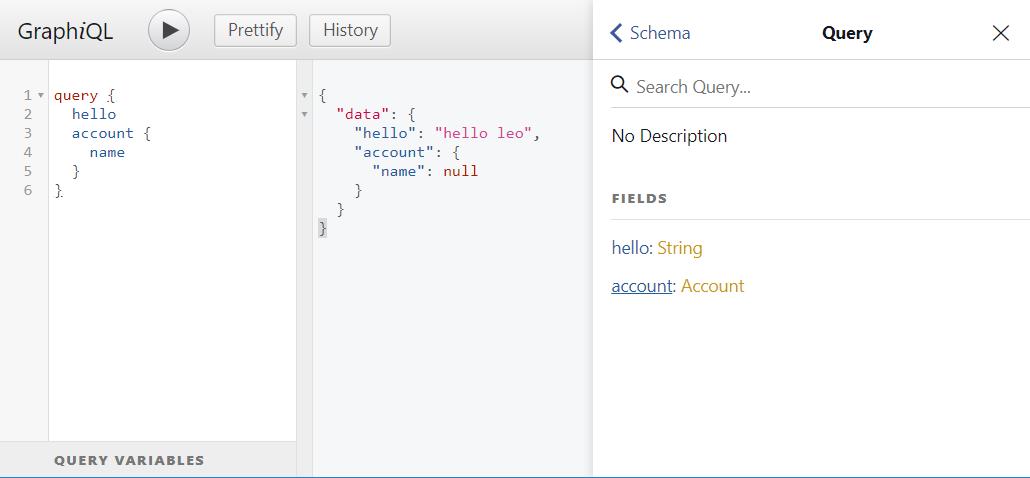
另外我们可以在 graphiql 界面右侧打开 Docs 查看我们定义的所有字段和描述信息。
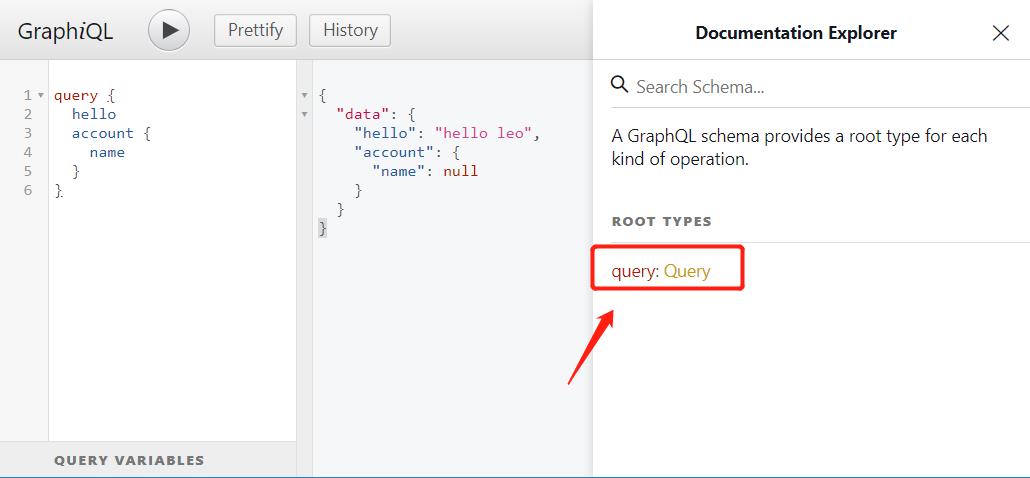
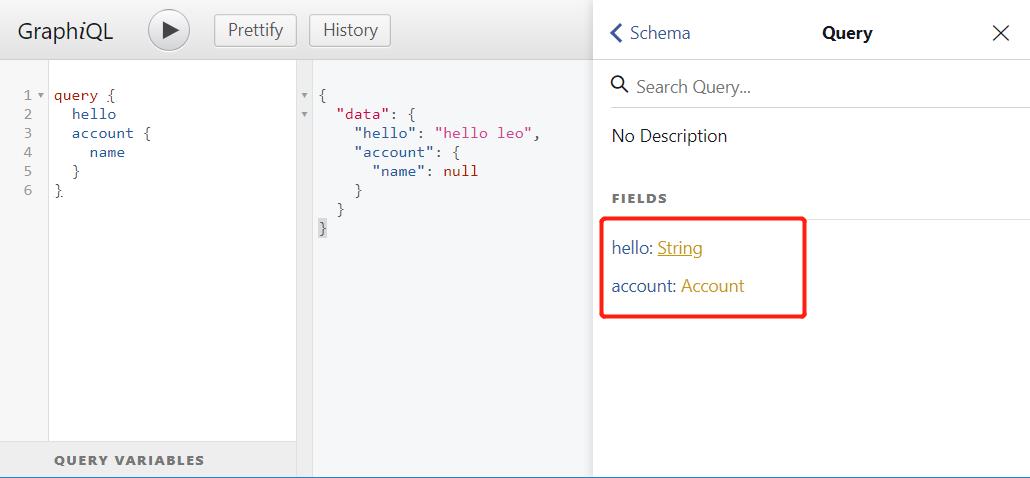
最终代码:
const express = require('express')
const { buildSchema } = require('graphql')
const graphqlHTTP = require('express-graphql')
// 构建schema,这里定义查询的语句和类型
const schema = buildSchema(`
type Query {
hero: String
}
`)
// 定义查询所对应的 resolver,也就是查询对应的处理器
const root = {
hero: () => {
return "I'm iron man"
}
}
const app = express()
// 将路由转发给 graphqlHTTP 处理
app.use('/graphql', graphqlHTTP({
schema: schema,
rootValue: root,
graphiql: true
}))
app.listen(3000)
2. 自定义类型查询
我们前面的查询中,已经将 hero 字段定义为 String 类型,但是常常开发中,我们又会碰到字段是多个类型,即字段也能指代对象类型(Object),比如一个 user 字段会有 name 、 age 等字段,而 name 返回字符串类型, age 返回数值类型。
这时候,我们可以对这个对象的字段进行次级选择(sub-selection)。GraphQL 查询能够遍历相关对象及其字段,使得客户端可以一次请求查询大量相关数据,而不像传统 REST 架构中那样需要多次往返查询。
我们可以新建一个查询类型来定义 user 字段返回的类型:
const schema = buildSchema(`
type User {
# 查询可以有备注!
name: String
age: Int
}
type Query {
hero: String
user: User
}
`)
在处理器中我们也要加上:
const root = {
hero: () => {
return "I'm iron man"
},
user: () => {
return {
name: 'leo',
age: 18
}
}
}
这边 Int/String 参数类型的问题,下一章介绍
四、参数类型和参数传递
1. 基本参数类型
String, Int, Float, Boolean 和 ID,这些基本参数类型可以在 schema 声明中直接使用。
Int:有符号 32 位整数。Float:有符号双精度浮点值。String:UTF‐8字符序列。Boolean:true或者false。ID:ID标量类型表示一个唯一标识符,通常用以重新获取对象或者作为缓存中的键。ID类型使用和String一样的方式序列化;然而将其定义为ID意味着并不需要人类可读型。
另外,我们可以使用 [类型] 来表示一类数组,如:
[Int]表示整型数组;[String]表示字符串型数组;
2. 参数传递
使用方式和 JS 参数传递一样,小括号内定义形参,但是参数需要定义类型。
使用 ! 代表参数不能为空。
下面案例:参数 teamName 是 String 类型,必须传递,而 number 参数也是 Int 类型,但是是非必须传递,最后输出的结果也是 String 类型。
type Query {
getHero(teamName: String!, number: Int): [String]
}
下面一个案例:
//...省略其他
const schema = buildSchema(`
type Query {
getHero(teamName: String!): [String]
}
`)
const root = {
getHero: ({teamName}) => {
// 这里的操作 实际开发中常常用在请求数据库
const hero = {
'三国': ['张飞', '刘备', '关羽'],
'复仇者联盟': ['钢铁侠', '美国队长', '绿巨人']
}
return hero[teamName]
}
}
//...省略其他
这时候我们在 GraphiQL 上输入查询,就会得到 复仇者联盟 的英雄数据了。
// 查询
query {
getHero(teamName:"复仇者联盟")
}
// 结果
{
"data": {
"getHero": [
"钢铁侠",
"美国队长",
"绿巨人"
]
}
}
3. 自定义返回类型
在实际开发中,我们返回的数据类型可能是一个对象,对象中可能既有 Int 类型的属性,也有 String 类型的值,等等,这里我们可以使用 自定义返回类型 来处理:
//...省略其他
const schema = buildSchema(`
type Hero {
name: String
age: Int
doSomething(thing: String): String
}
type Query {
getSuperHero(heroName: String!): Hero
}
`)
const root = {
getSuperHero: ({heroName}) => {
// 这里的操作 实际开发中常常用在请求数据库
const name = heroName
const age = 18
const doSomething = ({thing}) => {
return `I'm ${name}, I'm ${thing} now`
}
return { name, age, doSomething }
}
}
//...省略其他
这里指定了 getSuperHero 字段的返回类型是 Hero 类型,随后在上面定义了 Hero。
其中 Hero 类型中的 doSomething也是可以传递指定类型参数,并且指定返回类型。
下面看下输出情况:
// 查询
query {
getSuperHero(heroName:"IronMan") {
name
age
doSomething
}
}
// 结果
{
"data": {
"getSuperHero": {
"name": "IronMan",
"age": 46,
"doSomething": "I'm IronMan, I'm undefined now"
}
}
}
这里也可以给 doSomething 传递参数,就会获取到不同结果:
// 查询
query {
getSuperHero(heroName:"IronMan") {
name
age
doSomething(thing:"watching TV")
}
}
// 结果
{
"data": {
"getSuperHero": {
"name": "IronMan",
"age": 46,
"doSomething": "I'm IronMan, I'm watching TV now"
}
}
}
五、GraphQL客户端
这一节我们学习如何在客户端中访问 graphql 的接口。
1. 后端定义接口
我们先在后端将接口开发完成,这里跟前面差不多,但需要多一步,使用 express 向外暴露一个文件夹,供用户访问静态资源文件:
这里直接使用前一节的代码啦~
// index.js 开发 graphql 接口
//...省略其他
const schema = buildSchema(`
type Hero {
name: String
age: Int
doSomething(thing: String): String
}
type Query {
getSuperHero(heroName: String!): Hero
}
`)
const root = {
getSuperHero: ({heroName}) => {
// 这里的操作 实际开发中常常用在请求数据库
const name = heroName
const age = 46
const doSomething = ({thing}) => {
return `I'm ${name}, I'm ${thing} now`
}
return { name, age, doSomething }
}
}
const app = express()
app.use('/graphql', graphqlHTTP({
schema, rootValue: root, graphiql: true
}))
// 公开文件夹 使用户访问静态资源
app.use(express.static('public'))
app.listen(3000)
这样我们就给前端页面提供一个可以访问静态资源的功能。
这里还需要在根目录创建一个 public 文件夹,并在文件夹中添加 index.html 文件,此时的目录结构:
|-node_modules
|-public
|---index.html
|-index.js
|-package.json
2. 前端页面请求
然后给 index.html 添加按钮和事件绑定:
这里的变量 query 是个字符串类型,定义查询条件,在条件 GetSuperHero 中的参数,需要用 $ 符号来标识,并在实际查询 getSuperHero 中,作为参数的参数类型设置进来。
然后定义变量 variables ,指定属性的值,之后通过 fetch 发起请求:
<button onclick="getData()">获取数据</button>
<script>
function getData(){
const query = `
query GetSuperHero($heroName: String, $thing: String){
getSuperHero(heroName: $heroName){
name
age
doSomething(thing: $thing)
}
}
`
// 如果不需要其他参数 至少要传一个参数 否则会报错
// const query = `
// query GetSuperHero($heroName: String){
// getSuperHero(heroName: $heroName){
// name
// }
// }
// `
const variables = {heroName: '钢铁侠', thing: 'watching TV'}
fetch('./graphql', {
method: 'POST',
headers: {
'Content-Type': 'application/json',
'Accept': 'application/json'
},
body: JSON.stringify({
query, variables
})
})
.then(res => res.json())
.then(json => {
console.log(json)
})
}
</script>
当我们写完以后,点击 获取数据 就会在控制台打印下面的数据:
{
"data":{
"getSuperHero":{
"name":"钢铁侠",
"age":46,
"doSomething": "I'm 钢铁侠, I'm watching TV now"
}
}
}
3. 注意点
请求中的
query参数需要对照好有$符号的变量。
查询语句 queryGetSuperHero($heroName:String) 里参数 $heroName 中的 heroName ;
查询语句 getSuperHero(heroName:$heroName) 里类型 $heroName 中的 heroName ;
变量 variables 中的 heroName 属性;
这三个名称需要一样。
请求中需要将数据序列化操作。
body: JSON.stringify({ query, variables })
六、使用Mutations修改数据
1. Mutation 使用
根据前面的学习,我们知道,要做查询操作,需要使用 Query 来声明:
type Query {
queryHero(heroName: String): String
}
当我们要做修改操作,需要用到的是 Mutation :
type Mutation {
createHero(heroName: String): String
}
如果 Mutation 中字段的形参是自定义类型,则类型需要用 input 标识:
const schema = buildSchema(`
# 输入类型 用 input 标识
input HeroInput {
name: String
age: Int
}
# 查询类型
type Hero {
name: String
age: Int
}
type Mutation {
createHero(heroName: String): Hero
updateHero(heroName: String, hero: HeroInput): Hero
}
`)
注意下:这里需要至少定义一个 Query 不然 GraphiQL 会不显示查询:
type Query {
hero: [Hero]
}
2. Mutation 使用案例
先创建一个 schema ,内容为上一步【1. Mutation 使用】中定义的内容,这里不重复写。
然后模拟创建一个本地数据库 localDb, 用于模拟存放添加的超级英雄数据:
const localDb = {}
接下来声明 root 实现 schema 中的字段方法:
const root = {
hero() {
// 这里需要转成数组 因为前面定义了返回值是 [Hero] 类型
let arr = []
for(const key in localDb){
arr.push(localDb[key])
}
return arr
},
createHero({ input }) {
// 相当于数据库的添加操作
localDb[input.name] = input
return localDb[input.name]
},
updateHero({ id, input }) {
// 相当于数据库的更新操作
const update = Object.assign({}, localDb[id], input)
localDb[id] = update
return update
}
}
最后配置 graphqlHTTP 方法和启动服务器,这里就不多重复咯。
最终代码:
//...省略其他
const schema = buildSchema(`
# 输入类型 用 input 标识
input HeroInput {
name: String
age: Int
}
# 查询类型
type Hero {
name: String
age: Int
}
type Mutation {
createHero(input: HeroInput): Hero
updateHero(id: ID!, input: HeroInput): Hero
}
# 需要至少定义一个 Query 不要GraphiQL会不显示查询
type Query {
hero: [Hero]
}
`)
const localDb = {}
const root = {
hero() {
// 这里需要转成数组 因为前面定义了返回值是 [Hero] 类型
let arr = []
for(const key in localDb){
arr.push(localDb[key])
}
return arr
},
createHero({ input }) {
// 相当于数据库的添加操作
localDb[input.name] = input
return localDb[input.name]
},
updateHero({ id, input }) {
// 相当于数据库的更新操作
const update = Object.assign({}, localDb[id], input)
localDb[id] = update
return update
}
}
//...省略其他
现在我们可以启动服务器,在 GraphiQL 上测试下效果了。
我们是使用 mutation 的 createHero 字段添加两条数据:
mutation {
createHero(input: {
name: "钢铁侠"
age: 40
}){
name
age
}
}
mutation {
createHero(input: {
name: "美国队长"
age: 41
}){
name
age
}
}
然后使用 query 的 hero 字段查询添加的结果:
query {
hero {
name
age
}
}
这样我们就获取到刚才的添加结果:
{
"data": {
"hero": [
{
"name": "钢铁侠",
"age": 40
},
{
"name": "美国队长",
"age": 41
}
]
}
}
然后我们开始更新数据,使用 mutation 的 updateHero 字段将 美国队长 的 age 值修改为 18:
mutation {
updateHero(id: "美国队长", input: {
age: 18
}){
age
}
}
再使用 query 的 hero 字段查询下新的数据,会发现 美国队长 的 age 值已经更新为 18:
{
"data": {
"hero": [
{
"name": "钢铁侠",
"age": 40
},
{
"name": "美国队长",
"age": 18
}
]
}
}
七、认证和中间件
我们知道,修改数据的接口不能让所有人随意访问,所以需要添加权限认证,让有权限的人才可以访问。
在 express 中,可以很简单的使用中间件来将请求进行拦截,将没有权限的请求过滤并返回错误提示。
中间件实际上是一个函数,在接口执行之前,先拦截请求,再决定我们是否接着往下走,还是返回错误提示。
这在【六、使用Mutations修改数据】的最终代码上,在添加这个中间件:
//... 省略其他
const app = express()
const middleWare = (req, res, next) => {
// 这里是简单模拟权限
// 实际开发中 更多的是和后端进行 token 交换来判断权限
if(req.url.indexOf('/graphql') !== -1 && req.headers.cookie.indexOf('auth') === -1){
// 向客户端返回一个错误信息
res.send(JSON.stringify({
err: '暂无权限'
}))
return
}
next() // 正常下一步
}
// 注册中间件
app.use(middleWare)
//... 省略其他
这里的权限判断,只是简单模拟,实际开发中,更多的是和后端进行 token 交换来判断权限(或者其他形式)。
我们重启服务器,打开 http://localhost:3000/graphql ,发现页面提示错误了,因为 cookies 中没有含有 auth 字符串。
如果这里提示 TypeError:Cannotreadproperty'indexOf'ofundefined ,可以先不用管,因为浏览器中没有 cookies 的原因,其实前面的权限判断逻辑需要根据具体业务场景判断。
为了方便测试,我们在 chrome 浏览器控制台的 application 下,手动设置一个含有 auth 字符串的一个 cookies ,只是测试使用哦。
设置完成后,我们就能正常进入页面。
八、ConstructingTypes
在前面的介绍中,我们要创建一个 schema 都是使用 buildSchema 方法来定义,但我们也可以使用另外一种定义方式。
就是这里要学习使用的构造函数 graphql.GraphQLObjectType 定义,它有这么几个优点和缺点:
优点:报错提醒更直观,结构更清晰,更便于维护。
缺点:代码量上升。
1. 定义type(类型)
这里先将前面定义的 Hero 类型进行改造:
const graphql = require('graphql') // 需要引入
const HeroType = new graphql.GraphQLObjectType({
name: 'Hero',
fields: {
name:{ type: graphql.GraphQLString },
age:{ type: graphql.GraphQLInt },
}
})
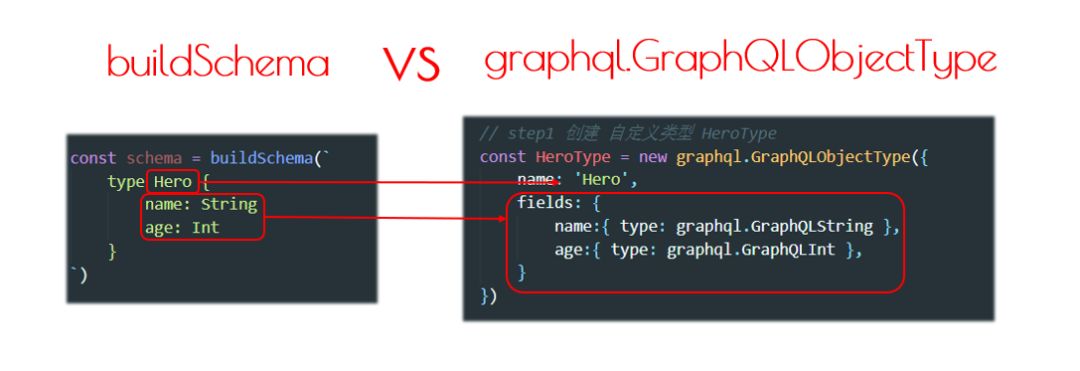
两者区别在于:
| 区别 | buildSchema |
graphql.GraphQLObjectType |
|---|---|---|
| 参数类型 | 字符串 | 对象 |
| 类名 | 跟在 type 字符后面,这里是 typeHero |
在参数对象的 name 属性上 |
| 属性定义 | 定义在类型后,键值对形式 | 定义在参数对象 fields 属性中,值为对象,每个属性名为键名,值也是对象,其中 type属性的值为 graphql 中的属性,下面会补充 |
补充:fields 属性中的子属性的类型通常有:
graphql.GraphQLStringgraphql.GraphQLIntgraphql.GraphQLBoolean....
即在 GraphQL后面跟上基本类型名称。
2. 定义query(查询)
定义查询的时候,跟之前类似,可以参照下面对比图理解,这里比较不同的是,多了个 resolve 的方法,这个方法是用来执行处理查询的逻辑,其实就是之前的 root 中的方法。
const QueryType = new graphql.GraphQLObjectType({
name: 'Query',
fields: {
// 一个个查询方法
getSuperHero: {
type: HeroType,
args: {
heroName: { type: graphql.GraphQLString }
},
// 方法实现 查询的处理函数
resolve: function(_, { heroName }){
const name = heroName
const age = 18
return { name, age }
}
}
}
})
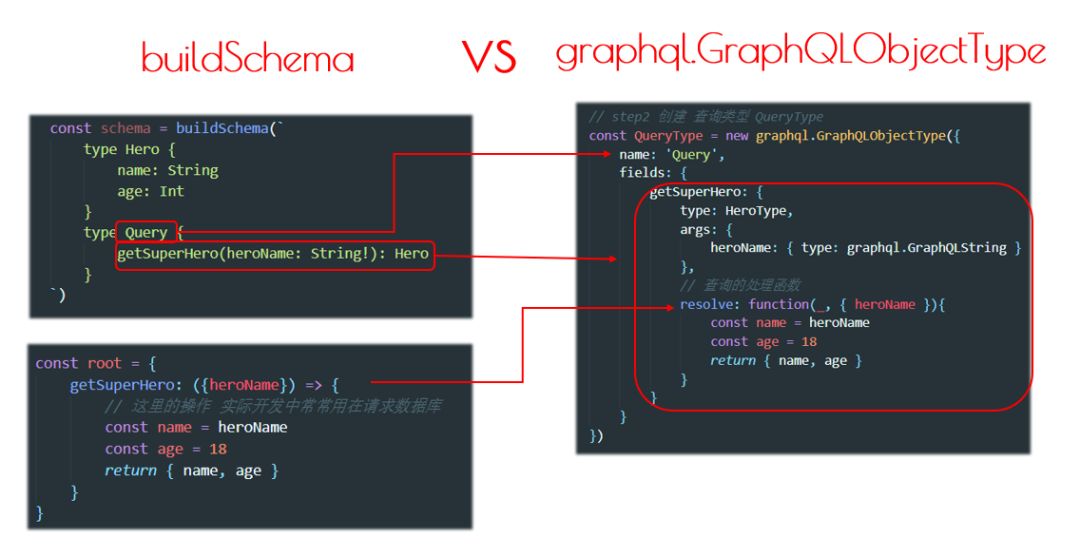
3. 创建 schema
创建的时候只需实例化并且将参数传入即可:
// step3 构造 schema
const schema = new graphql.GraphQLSchema({ query: QueryType})
最后使用也是和前面一样:
const app = express()
app.use('/graphql', graphqlHTTP({
schema,
graphiql: true
}))
app.listen(3000)
九、与数据库结合实战
我们试着使用前面所学的内容,开发一个简单的实践项目:
通过 GraphiQL 页面,往 Mongodb 中插入和更新数据,主要用到【六、使用Mutations修改数据】章节的操作。
1. 搭建并启动本地 Mongodb 数据库
首先我们可以到 Mongodb 官网 选择对应平台和版本下载安装。
下载安装步骤,可以参考 mongoDB下载、安装和配置,这里就不多介绍哟~~
安装完成后,我们打开两个终端,分别执行下面两行命令:
// 终端1 启动数据库
mongod --dbpath c:\leo\app\mongodb\data\db
// 终端2 进入数据库命令行操作模式
mongo
2. 连接数据库,创建 Schema 和 Model
首先我们新建一个文件 db.js ,并 npm install mongoose 安装 mongoose ,然后写入下面代码,实现连接数据库:
const express = require('express')
const { buildSchema } = require('graphql')
const graphqlHTTP = require('express-graphql')
const mongoose = require('mongoose')
const DB_PATH = 'mongodb://127.0.0.1:27017/hero_table'
const connect = () => {
// 连接数据库
mongoose.connect(DB_PATH)
// 连接断开
mongoose.connection.on('disconnected', () => {
mongoose.connect(DB_PATH)
})
// 连接失败
mongoose.connection.on('error', err => {
console.error(err)
})
// 连接成功
mongoose.connection.on('connected', async () => {
console.log('Connected to MongoDB connected', DB_PATH)
})
}
connect()
然后创建 Schema 和 Model:
let HeroSchema = new mongoose.Schema({
name: String,
age: Number
})
let HeroModel = mongoose.model('hero',HeroSchema, 'hero_table')
3. 声明查询语句
这一步,还是先使用【六、使用Mutations修改数据】章节的操作逻辑,也就是先用字符串创建查询,而不使用 GraphQLObjectType 创建:
const schema = buildSchema(`
# 输入类型 用 input 标识
input HeroInput {
name: String
age: Int
}
# 查询类型
type Hero {
name: String
age: Int
}
type Mutation {
createHero(input: HeroInput): Hero
updateHero(hero: String!, input: HeroInput): Hero
}
# 需要至少定义一个 Query 不要GraphiQL会不显示查询
type Query {
hero: [Hero]
}
`)
这边案例有稍作修改
4. 实现添加数据和更新数据的逻辑
这边处理添加数据和更新数据的逻辑,就要修改之前声明的 root 的操作内容了:
const root = {
hero() {
return new Promise( (resolve, reject) => {
HeroModel.find((err, res) => {
if(err) {
reject(err)
return
}
resolve(res)
})
})
},
createHero({ input }) {
// 实例化一个Model
const { name, age } = input
const params = new HeroModel({ name, age })
return new Promise( (resolve, reject) => {
params.save((err, res) => {
if(err) {
reject(err)
return
}
resolve(res)
})
})
},
updateHero({ hero, input }) {
const { age } = input
return new Promise ((resolve, reject) => {
HeroModel.update({name: hero}, {age}, (err, res) => {
if(err) {
reject(err)
return
}
resolve(res)
})
})
}
}
5. 模拟测试
最后我们在 GraphiQL 页面上模拟测试一下,首先添加两个英雄,钢铁侠和美国队长,并设置他们的 age/name 属性:
mutation {
createHero(input: {
name: "钢铁侠"
age: 40
}){
name
age
}
}
mutation {
createHero(input: {
name: "美国队长"
age: 20
}){
name
age
}
}
页面和接口没有报错,说明我们添加成功,数据库中也有这两条数据了:

在测试下查询:
query {
hero {
name
age
}
}
查询也正常,接下来测试下更新,将美国队长的 age 修改为 60:
mutation {
updateHero(hero: "美国队长", input: {
age: 60
}){
age
}
}
到这一步,我们也算是将这个练习做完了。
总结
GraphQL是一种 API 的查询语言,是 REST API 的替代品。GraphQL可以使用一个请求,获取所有想要的数据。创建查询的方式有两种:使用
buildSchema或者GraphQLObjectType。查询操作用
Query,修改操作用Mutations。查询类型用
type,输入类型用input。
其实 GraphQL 还是很简单好用的呢~~~
本文首发在 [pingan8787个人博客] (http://www.pingan8787.com),如需转载请保留个人介绍
以上是关于GraphQL真香入门教程的主要内容,如果未能解决你的问题,请参考以下文章